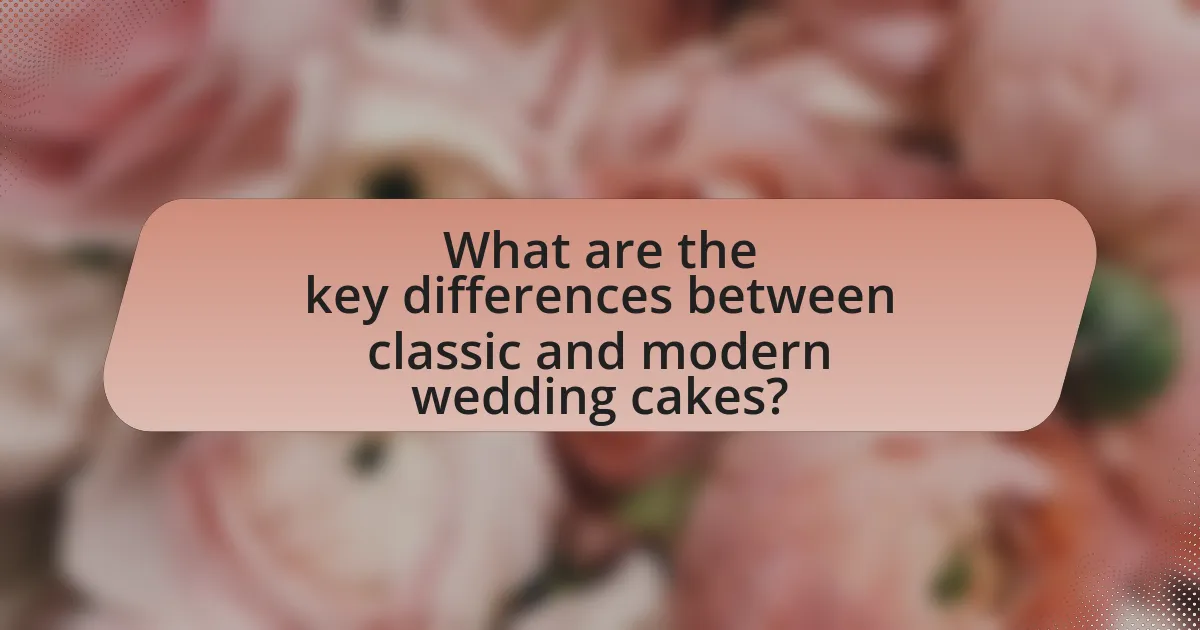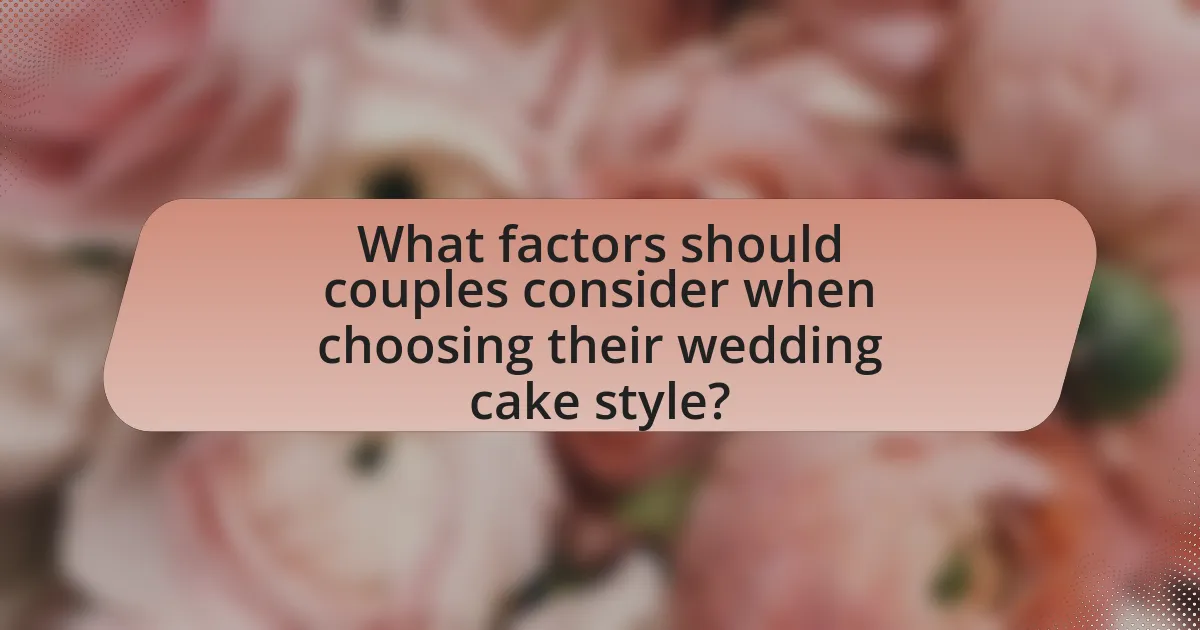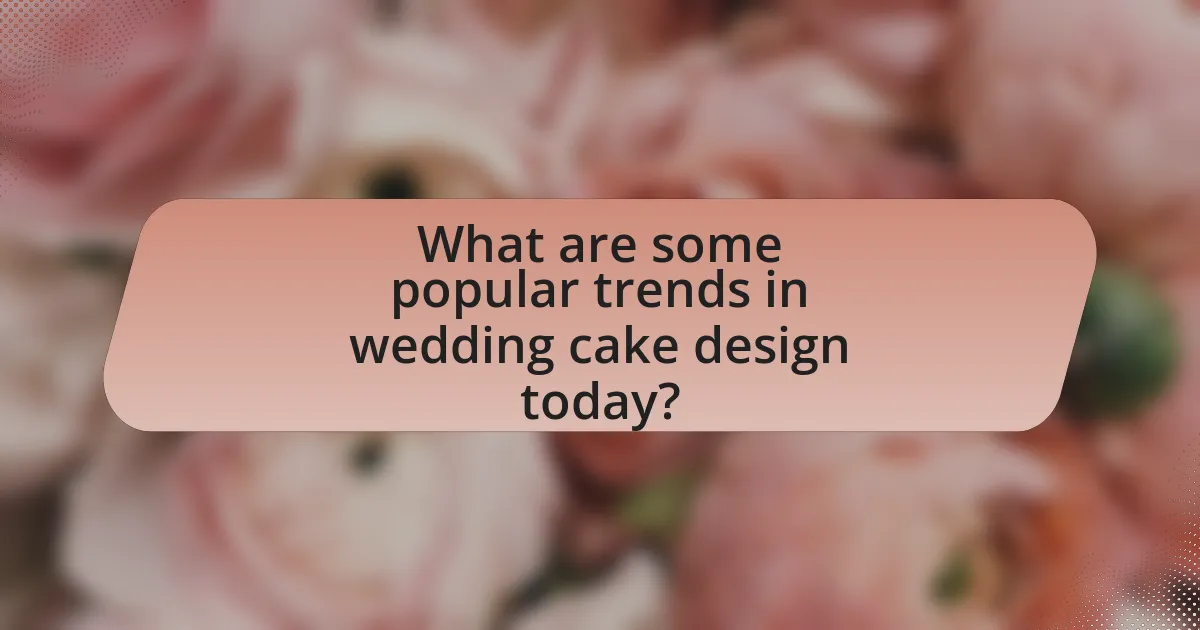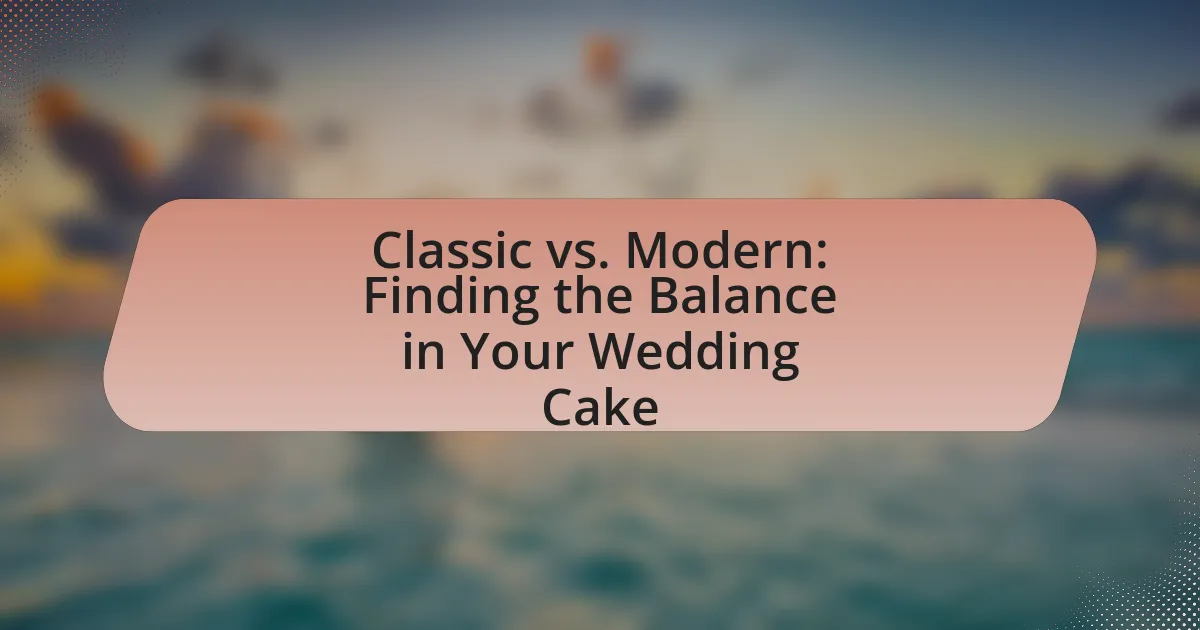The article examines the key differences between classic and modern wedding cakes, highlighting their distinct designs, flavors, and cultural significance. Classic wedding cakes are characterized by traditional multi-tiered structures, elegant decorations, and flavors like vanilla and fruitcake, while modern cakes embrace innovative designs, bold colors, and unique flavor combinations such as salted caramel and matcha. The discussion includes how couples can balance classic and modern elements to reflect their personalities and wedding themes, as well as considerations for dietary restrictions, venue aesthetics, and budget constraints. Additionally, the article explores current trends in cake design and flavor, emphasizing the importance of personalization in contemporary wedding celebrations.

What are the key differences between classic and modern wedding cakes?
Classic wedding cakes are typically characterized by their traditional designs, often featuring multiple tiers, intricate piping, and classic flavors like vanilla or fruitcake. In contrast, modern wedding cakes embrace innovative designs, including unconventional shapes, bold colors, and unique flavor combinations such as salted caramel or red velvet. The shift from classic to modern reflects changing tastes and the desire for personalization in wedding celebrations, with modern cakes often incorporating elements like edible flowers or geometric patterns, which are less common in classic designs. This evolution in cake styles highlights a broader trend in weddings towards individuality and creativity.
How do classic wedding cakes differ in design and flavor?
Classic wedding cakes typically differ from modern cakes in both design and flavor. In terms of design, classic wedding cakes are often characterized by their multi-tiered structure, smooth fondant or buttercream icing, and traditional decorations such as floral arrangements or intricate piping. These designs emphasize elegance and formality, often reflecting historical styles that date back to the Victorian era. Flavor-wise, classic wedding cakes commonly feature traditional flavors such as vanilla, almond, or fruitcake, which are often paired with rich fillings like buttercream or fruit preserves. This contrasts with modern wedding cakes, which may incorporate a wider variety of flavors and more innovative designs, including unconventional shapes and bold colors. The preference for classic elements in wedding cakes is supported by their longstanding cultural significance and the desire for timelessness in wedding celebrations.
What traditional elements define a classic wedding cake?
A classic wedding cake is traditionally defined by its multi-tiered structure, white or ivory color, and rich flavors such as vanilla or almond. These cakes often feature fondant or buttercream icing, which provides a smooth finish and can be adorned with intricate decorations like floral designs, lace patterns, or sugar figurines. Historically, the white color symbolizes purity and new beginnings, while the multi-tiered design represents prosperity and good fortune for the couple. The use of fruitcake or sponge cake as the base is also common, reflecting traditional recipes passed down through generations.
How do flavors and fillings vary in classic wedding cakes?
Classic wedding cakes typically feature traditional flavors such as vanilla, chocolate, and almond, while fillings often include buttercream, fruit preserves, or ganache. These flavors and fillings reflect historical preferences, with vanilla being the most popular choice due to its versatility and appeal. Additionally, buttercream has been a staple filling for its smooth texture and ability to complement various cake flavors. The use of fruit preserves adds a layer of freshness, while ganache provides richness, creating a balance that has been favored in classic wedding cake designs.
What characteristics define modern wedding cakes?
Modern wedding cakes are characterized by their unique designs, innovative flavors, and personalized elements. These cakes often feature minimalist aesthetics, such as clean lines and geometric shapes, which contrast with traditional ornate decorations. Additionally, modern wedding cakes frequently incorporate unconventional flavors like lavender, matcha, or salted caramel, moving beyond classic vanilla and chocolate. Customization is also a key aspect, with couples opting for designs that reflect their personalities or wedding themes, such as incorporating fresh flowers, metallic accents, or even edible art. This shift towards personalization and creativity in cake design is supported by trends in the wedding industry that emphasize individuality and self-expression.
How do contemporary designs reflect current trends?
Contemporary designs reflect current trends by incorporating minimalist aesthetics, sustainable materials, and personalized elements. These designs often prioritize clean lines and simplicity, aligning with the modern preference for understated elegance. For instance, the use of organic ingredients and eco-friendly packaging in wedding cakes showcases a growing trend towards sustainability in the culinary arts. Additionally, customization options, such as unique flavors and personalized decorations, cater to individual tastes, reflecting the current consumer desire for authenticity and personal expression in celebrations.
What innovative flavors are popular in modern wedding cakes?
Innovative flavors popular in modern wedding cakes include lavender honey, matcha green tea, and salted caramel. These flavors reflect a trend towards unique and sophisticated taste profiles, moving away from traditional vanilla and chocolate. For instance, lavender honey combines floral notes with sweetness, appealing to couples seeking a distinct experience. Matcha green tea offers an earthy flavor that resonates with health-conscious couples, while salted caramel provides a rich, sweet-salty contrast that has gained widespread popularity. These flavors not only enhance the cake’s taste but also contribute to the overall aesthetic and theme of modern weddings.
Why is it important to find a balance between classic and modern styles?
Finding a balance between classic and modern styles is important because it allows for a harmonious blend that appeals to diverse tastes while honoring tradition. This balance ensures that a wedding cake can reflect the couple’s unique identity, combining timeless elegance with contemporary trends. For instance, a study by The Knot in 2022 revealed that 60% of couples prefer cakes that incorporate both classic elements, like fondant and tiered designs, and modern touches, such as unique flavors or geometric shapes. This integration not only enhances visual appeal but also caters to a wider range of preferences, making the cake a centerpiece that resonates with all guests.
How can a balanced cake reflect the couple’s personality?
A balanced cake can reflect the couple’s personality by harmonizing flavors, textures, and design elements that represent their individual tastes and shared values. For instance, a couple who enjoys both traditional and contemporary styles may choose a cake that combines classic flavors like vanilla and chocolate with modern design elements such as geometric patterns or bold colors. This blend showcases their unique identities while also emphasizing their commitment to balance in their relationship. Additionally, the choice of ingredients, such as organic or locally sourced items, can further illustrate their values and lifestyle preferences, reinforcing the idea that the cake is a true representation of who they are as a couple.
What role does the wedding theme play in cake selection?
The wedding theme significantly influences cake selection by guiding the design, flavor, and overall presentation of the cake. A cohesive theme ensures that the cake complements the wedding’s aesthetic, whether it is classic, modern, rustic, or whimsical. For example, a vintage-themed wedding may feature a cake adorned with lace and floral elements, while a modern wedding might opt for sleek lines and minimalistic designs. This alignment enhances the visual harmony of the event, making the cake a focal point that resonates with the chosen theme.

What factors should couples consider when choosing their wedding cake style?
Couples should consider their wedding theme, personal taste, and dietary restrictions when choosing their wedding cake style. The wedding theme influences the cake’s design, ensuring it complements the overall aesthetic of the event. Personal taste is crucial as it reflects the couple’s preferences in flavor and appearance, while dietary restrictions, such as allergies or vegan choices, dictate the ingredients and cake type. According to a survey by The Knot, 70% of couples prioritize flavor over design, highlighting the importance of personal preference in the decision-making process.
How does the wedding venue influence cake design?
The wedding venue significantly influences cake design by dictating the overall aesthetic, size, and theme of the cake. For instance, a rustic barn venue may inspire a cake with natural elements like floral decorations and a textured finish, while a luxurious ballroom might call for a more elegant, multi-tiered cake adorned with intricate details. Additionally, the venue’s color scheme and decor can guide the cake’s color palette and style, ensuring cohesion throughout the event. This alignment between the cake design and the venue enhances the visual harmony of the wedding, making the cake a focal point that complements the surroundings.
What considerations should be made for indoor vs. outdoor venues?
Indoor venues typically offer climate control, which is crucial for preserving the integrity of wedding cakes, especially those with delicate decorations or perishable ingredients. In contrast, outdoor venues require considerations for weather conditions, such as heat or humidity, which can compromise cake stability and presentation. For example, a study by the American Society of Baking highlights that cakes exposed to high temperatures can melt or sag, emphasizing the need for proper planning based on venue type. Additionally, indoor venues often provide more consistent lighting, enhancing the visual appeal of the cake, while outdoor settings may necessitate additional measures to protect the cake from elements like wind or insects.
How can the venue’s aesthetic guide cake choices?
The venue’s aesthetic can significantly guide cake choices by influencing the design, color palette, and overall theme of the cake. For instance, a rustic venue may call for a cake with natural elements, such as floral decorations or a textured finish, while a modern venue might favor sleek lines and bold colors. This alignment ensures that the cake complements the surrounding decor, creating a cohesive visual experience. Research indicates that visual harmony in event design enhances guest satisfaction, reinforcing the importance of matching the cake to the venue’s aesthetic.
What budget considerations are involved in selecting a wedding cake?
Selecting a wedding cake involves several budget considerations, primarily the size, design complexity, flavor choices, and vendor pricing. The size of the cake directly impacts the cost, as larger cakes require more ingredients and labor. Design complexity, such as intricate decorations or custom themes, can significantly increase the price due to the additional time and skill required. Flavor choices also affect the budget; premium ingredients for gourmet flavors typically cost more than standard options. Lastly, vendor pricing varies widely based on reputation, location, and experience, influencing the overall budget. According to a survey by The Knot, couples in 2021 spent an average of $350 on their wedding cake, highlighting the importance of these factors in budget planning.
How do classic cakes compare to modern cakes in terms of cost?
Classic cakes generally cost less than modern cakes due to simpler ingredients and traditional baking methods. Classic cakes often utilize basic components like flour, sugar, eggs, and butter, which are less expensive compared to the specialized ingredients and intricate designs commonly found in modern cakes. For instance, a classic vanilla or chocolate cake may range from $2 to $5 per slice, while modern cakes, which may include fondant, elaborate decorations, and unique flavor combinations, can cost between $6 to $12 per slice. This price difference reflects the additional labor and materials required for modern cake designs.
What are some tips for staying within budget while achieving desired styles?
To stay within budget while achieving desired styles for a wedding cake, prioritize planning and research. First, set a clear budget limit and identify essential elements of the cake design that align with your vision. Next, consider simpler designs that use fewer intricate details, as these often reduce costs significantly. For instance, opting for a single-tier cake or a smaller cake with a decorative sheet cake can maintain style while minimizing expenses. Additionally, sourcing ingredients locally or choosing seasonal flavors can lower costs without sacrificing quality. According to a survey by The Knot, couples spent an average of $350 on their wedding cake in 2021, indicating that budget-conscious choices can still yield beautiful results.
How can seasonal ingredients impact cake flavor and design?
Seasonal ingredients significantly enhance cake flavor and design by incorporating fresh, vibrant tastes and visually appealing elements that reflect the time of year. For example, using summer fruits like strawberries or peaches can add natural sweetness and moisture, while autumn spices such as cinnamon and nutmeg can create warmth and depth in flavor. Additionally, seasonal ingredients often inspire design choices; a cake adorned with fresh berries in summer or decorated with autumn leaves in fall can visually represent the season, making the cake more thematic and appealing. This approach not only elevates the sensory experience but also aligns with the growing trend of farm-to-table practices, emphasizing freshness and sustainability in culinary creations.
What seasonal flavors are best for classic wedding cakes?
The best seasonal flavors for classic wedding cakes include vanilla, lemon, and almond for spring; strawberry, raspberry, and peach for summer; pumpkin, spice, and apple for fall; and chocolate, peppermint, and eggnog for winter. These flavors align with traditional wedding cake preferences while incorporating seasonal ingredients, enhancing freshness and taste. For example, lemon and almond are often favored in spring weddings due to their light and refreshing profiles, while pumpkin spice is a popular choice in autumn, reflecting the season’s harvest.
How can modern cakes incorporate seasonal trends effectively?
Modern cakes can effectively incorporate seasonal trends by utilizing ingredients, flavors, and designs that reflect the current season. For instance, spring cakes can feature fresh fruits like strawberries and floral decorations, while autumn cakes may include spices such as cinnamon and pumpkin. Seasonal trends can also be integrated through color palettes that align with seasonal themes, such as pastels for spring or warm earth tones for fall. According to a survey by The Knot, 40% of couples choose seasonal flavors for their wedding cakes, indicating a strong preference for aligning cake choices with seasonal trends. This approach not only enhances the aesthetic appeal but also resonates with guests’ seasonal experiences, making the cake a memorable centerpiece.

What are some popular trends in wedding cake design today?
Popular trends in wedding cake design today include the use of bold colors, geometric shapes, and unique flavor combinations. Bold colors, such as deep blues and rich burgundies, are increasingly favored over traditional white, allowing couples to express their personalities. Geometric shapes, including hexagons and triangles, are replacing classic round tiers, adding a modern touch to the design. Additionally, couples are opting for unconventional flavors like lavender, matcha, and salted caramel, moving away from standard vanilla and chocolate. These trends reflect a shift towards personalization and creativity in wedding cake design, catering to contemporary tastes and aesthetics.
How are couples personalizing their wedding cakes?
Couples are personalizing their wedding cakes by incorporating unique flavors, custom designs, and meaningful decorations that reflect their personalities and love stories. For instance, many couples choose flavors that hold sentimental value, such as the cake flavor from their first date or a family recipe. Additionally, custom designs often include elements like monograms, themed decorations, or edible images that represent shared interests or hobbies. According to a survey by The Knot, 40% of couples opt for non-traditional cake shapes or styles, further showcasing their desire for individuality in their wedding cakes.
What unique elements can be added to reflect personal stories?
Unique elements that can be added to reflect personal stories in wedding cakes include personalized cake toppers, custom flavors that hold significance, and edible images or inscriptions that represent shared memories. Personalized cake toppers can depict the couple’s hobbies or interests, making the cake a visual representation of their journey together. Custom flavors, such as a favorite dessert from a memorable date, evoke nostalgia and connection. Edible images or inscriptions can feature quotes or symbols meaningful to the couple, enhancing the cake’s emotional resonance. These elements not only make the cake unique but also serve as a tangible expression of the couple’s love story.
How do custom toppers and decorations enhance personalization?
Custom toppers and decorations enhance personalization by allowing couples to express their unique identities and preferences on their wedding cakes. These personalized elements can reflect themes, interests, or significant moments in the couple’s relationship, making the cake a meaningful centerpiece. For instance, a study by The Knot found that 70% of couples choose custom cake designs to showcase their personalities, indicating a strong desire for individuality in wedding celebrations. This customization not only adds aesthetic value but also creates a memorable experience for both the couple and their guests.
What are the emerging flavor trends in wedding cakes?
Emerging flavor trends in wedding cakes include unique combinations such as lavender and lemon, chocolate and chili, and matcha with vanilla. These flavors reflect a shift towards more adventurous and sophisticated palettes among couples. According to a survey by The Knot, 30% of couples are opting for non-traditional flavors, indicating a growing preference for innovative tastes over classic vanilla or chocolate. Additionally, the use of natural ingredients and organic flavors is on the rise, aligning with broader trends in health and sustainability.
How are couples experimenting with non-traditional flavors?
Couples are experimenting with non-traditional flavors in their wedding cakes by incorporating unique ingredients such as lavender, matcha, and exotic fruits like passionfruit and guava. This trend reflects a growing desire for personalization and creativity in wedding celebrations, moving away from traditional vanilla and chocolate options. According to a survey by The Knot, 30% of couples now choose unconventional flavors, indicating a significant shift in preferences towards more adventurous and memorable cake experiences.
What role do dietary restrictions play in flavor selection?
Dietary restrictions significantly influence flavor selection by limiting the available options for individuals with specific needs, such as allergies, intolerances, or lifestyle choices. For instance, a person with a gluten intolerance will avoid traditional wheat-based cakes, leading to the selection of gluten-free alternatives that may incorporate different flavor profiles, such as almond or coconut. Additionally, dietary preferences like veganism necessitate the use of plant-based ingredients, which can alter the flavor dynamics of a cake, often requiring creative combinations of fruits, nuts, and alternative sweeteners to achieve desired tastes. This adaptation to dietary restrictions not only ensures inclusivity but also encourages innovation in flavor combinations, as bakers explore new ingredients to meet diverse needs while maintaining appeal.
What practical tips can help couples achieve the perfect balance in their wedding cake?
To achieve the perfect balance in a wedding cake, couples should consider a harmonious blend of flavors, designs, and sizes that reflect both classic and modern elements. Selecting complementary flavors, such as a traditional vanilla paired with a contemporary salted caramel, can create a pleasing taste experience. Additionally, incorporating a classic tiered structure with modern decorative elements, like geometric patterns or fresh flowers, can visually unify the cake. Couples should also ensure the cake size accommodates their guest list while allowing for a balanced presentation; a cake that is too small may appear inadequate, while an overly large cake can overwhelm the table setting. These strategies help couples create a wedding cake that is both aesthetically pleasing and delicious, satisfying diverse guest preferences while honoring their personal style.
